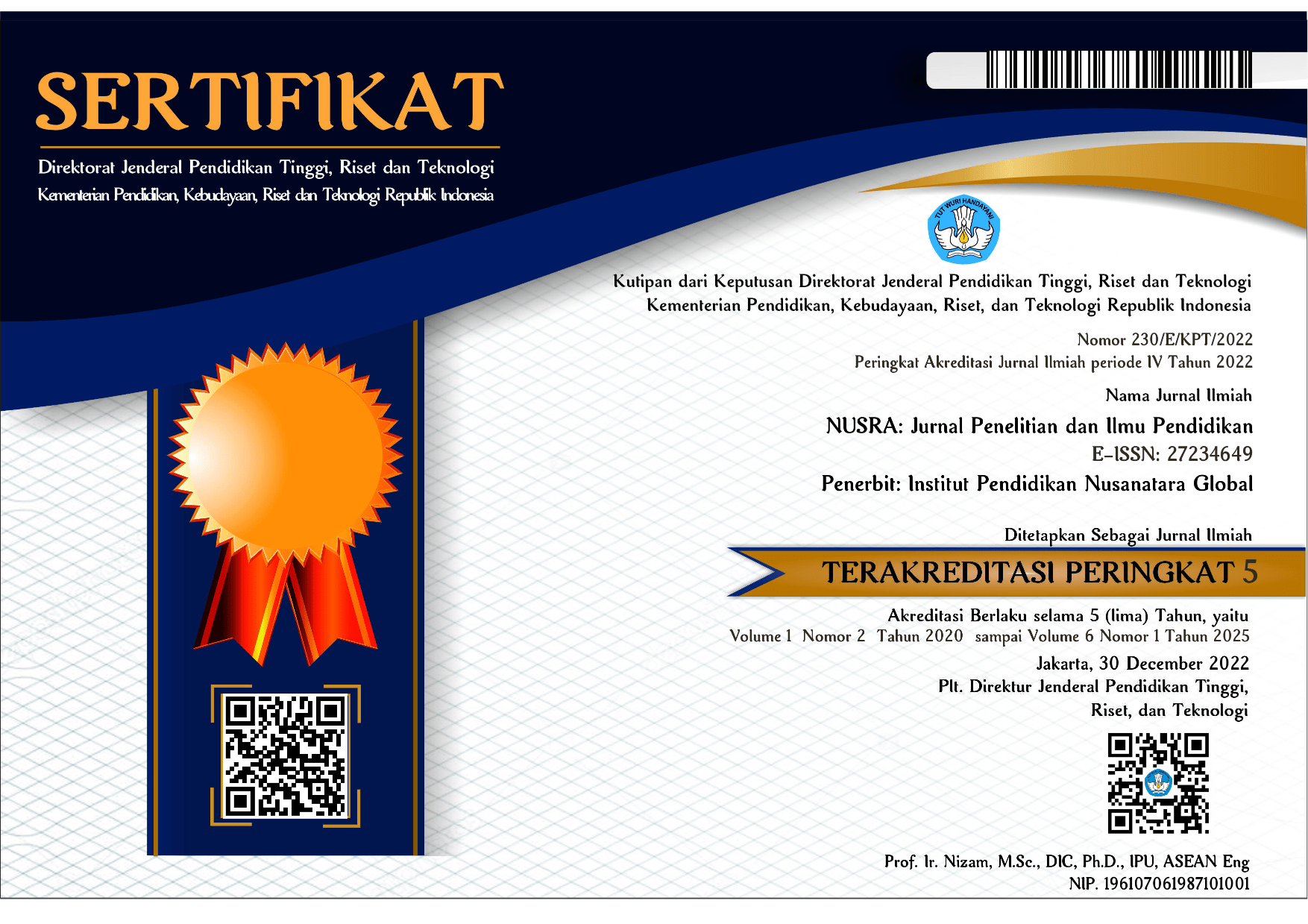Implementation of Lesson Plan with Zone Proxima Development at MI Alam Ali Thaibah Cibitung Bekasi
DOI:
https://doi.org/10.55681/nusra.v5i1.2178Keywords:
Lesson Plan, ZPD, Natural SchoolAbstract
MI Alam Ali Thaibah is a formal school that employs the natural school curriculum as its primary curriculum. In the teaching and learning process, the natural school curriculum is integrated with the national curriculum. The concept of the natural school combines three pillars of education: faith, knowledge, and leadership, as reflected in the vision and mission of MI Alam Ali Thaibah. The school envisions producing leaders who are devout, knowledgeable, and possess noble character, becoming a source of blessing for the entire universe. The mission includes fostering students' awareness of their responsibilities as servants of Allah, creating an environment that upholds moral values, instilling religious habits, preparing students to be trustworthy leaders, providing basic entrepreneurship education for student independence, developing effective communication skills, honing emotional intelligence in interactions, facilitating students to acquire extensive knowledge, and instilling awareness of the importance of preserving the environment.implementation of ZPD Lesson Plan (RPP) in MI Alam Ali Thaibah in Cibitung - Bekasi.this research employed qualitative research, the result show that the target audience for this community service activity is the teachers of MI Alam Ali Thaibah in Cibitung - Bekasi. The presentation of community service material for these teachers includes lectures, demonstrations, and practical exercises with question and answer sessions. Lectures are used to explain introductory concepts and theories of teaching media, demonstrations illustrate the stages of creating RPP using the ZPD method, and question and answer sessions provide participants with the opportunity to consult on overcoming challenges in implementing teaching techniques.
Downloads
References
Gardner, H. (1993). Multiple Intelligences: The Theory in Practice. Basic Books.
Gunawan, I. (2017). Implementasi Konsep Zone of Proximal Development (ZPD) dalam Pembelajaran IPA Berbasis Eksperimen pada Siswa Sekolah Dasar. Jurnal Pendidikan: Teori, Penelitian, dan Pengembangan, 2(2), 189-199
Guskey, T. R. (2000). Evaluating professional development. Thousand Oaks, CA: Corwin Press.
Sutherland, T. E. (1992). The Zone of Proximal Development and the Genesis of Self-Regulation. Contemporary Educational Psychology, 17(3), 198–217. https://doi.org/10.1016/0361476X(92)90011-P
Tharp, R. G., & Gallimore, R. (1988). Rousing Minds to Life: Teaching, Learning, and Schooling in Social Context. Cambridge University Press.
Johnson, D. W., & Johnson, R. T. (1987). Learning Together and Alone: Cooperative, Competitive, and Individualistic Learning. Prentice Hall.
Tomlinson, C. A. (1999). The Differentiated Classroom: Responding to the Needs of All Learners. ASCD.
Hall, T., Strangman, N., & Meyer, A. (2003). Differentiated instruction and implications for UDL implementation. Wakefield, MA: National Center on Accessing the General Curriculum. https://aem.cast.org/about/publications/2003/ncac-differentiated-instruction-udl.html
Rickinson, M., Dillon, J., Teamey, K., Morris, M., Choi, M. Y., Sanders, D., & Benefield, P. (2004). A review of research on outdoor learning. National Foundation for Educational Research and King’s College London.https://www.education.gov.uk/publications/eOrderingDownload/RR578.pdf
Ding, Y., Zhao, X., & Mok, I. A. C. (2013). Application of the zone of proximal development in designing English as a second language instruction. International Journal of English Language Teaching, 1(1), 61-69.
Kozulin, A., Gindis, B., Ageyev, V. S., & Miller, S. M. (2003). Vygotsky’s Educational Theory in Cultural Context. Cambridge University Press.
Schön, D. A. (1983). The Reflective Practitioner: How Professionals Think in Action. Basic Books
Wertsch, J. V. (1985). Vygotsky and the Social Formation of Mind. Harvard University Press.
Mercer, N., Dawes, L., & Staarman, J. K. (2009). Dialogic teaching in the primary science classroom. Language and Education, 23(4), 353-369. https://doi.org/10.1080/09500780902720418
Leithwood, K., Harris, A., & Hopkins, D. (2008). Seven strong claims about successful school leadership. School Leadership & Management, 28(1), 27-42.
Hallinger, P., & Heck, R. H. (1996). Reassessing the principal's role in school effectiveness: A review of empirical research, 1980–1995. Educational Administration Quarterly, 32(1), 5-44
Hargreaves, A., & Dawe, R. (1990). Paths of professional development: Contrived collegiality, collaborative culture, and the case of peer coaching. Teaching and Teacher Education, 6(3), 227-241.
Little, J. W. (1990). The persistence of privacy: Autonomy and initiative in teachers’ professional relations. Teachers College Record, 91(4), 509-536.
Ingersoll, R. M., & Strong, M. (2011). The impact of induction and mentoring programs for beginning teachers: A critical review of the research. Review of Educational Research, 81(2), 201-233.
Smith, T. M., & Ingersoll, R. M. (2004). What are the effects of induction and mentoring on beginning teacher turnover? American Educational Research Journal, 41(3),681-714. https://www.jstor.org/stable/3699470
Stufflebeam, D. L., Madaus, G. F., & Zhang, G. (2014). The CIPP Evaluation Model: How to Evaluate for Improvement and Accountability.Guilford Publications.
Vygotsky, L. S. (1978). Mind in Society: The Development of Higher Psychological Processes. Harvard University Press.
Downloads
Published
How to Cite
Issue
Section
License
Copyright (c) 2024 Darmawati

This work is licensed under a Creative Commons Attribution-ShareAlike 4.0 International License.














